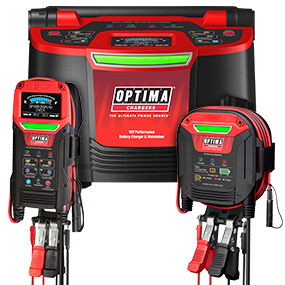-
You may want to consider using a good-quality battery maintenance device to keep the battery properly maintained during storage, preferably units that are microprocessor-controlled and have specific settings for AGM batteries. This is the method that OPTIMA® Batteries recommends:
- When your vehicle goes into storage, connect the maintainer – with the battery either in or out of the vehicle. This will ensure a full charge when you're ready to use your battery again. (Always remember to follow manufacturer instructions.)
- Some battery maintainers, like the OPTIMA Chargers D200+, Digital 400, D400+, Digital 1200 & D1200+ 12V Performance Battery Charger and Maintainer, also include ring terminal leads. These will offer easier access to maintain the battery both during storage and in between uses. Hook up the leads to the battery connections and extend them so they're safely accessible from under a bumper or wheel well. The leads can remain there indefinitely, so you'll never have to open the hood to keep the battery fully charged.
- You'll extend the life of your battery and ensure your vehicle is ready to use with these simple battery storage tips. Just remember – check the battery's voltage before your first drive no matter which storage method you use.
-
The OPTIMA® battery is truly carefree. When it's maintained properly you won't have to worry about leaking, corrosion or gassing. Inspect your battery terminal connections every now and then to ensure they are clean, snug and protected from the elements.
Open circuit voltage (OCV) and storage:
34 / 34R / 34/78 / 34M / 75/25 / 78 / 35 / 25
(about 12.6-12.8 volts for a new, fully charged battery)
DH5 / DH6 / DH7 / D34 / D34/78 / D27M / D31M / D27F / D75/25 / D35 / D31T / D31A / D51 / D51R / DS46B24R / D34M
(about 13.0-13.2 volts for a new, fully charged battery)
QUAD7 / QUAD12 / QUAD14 / QUAD16 / QUAD20 / Q31M-DP120 / Q31M-DC150 / QH6
(about 14.0 volts for a new, fully charged battery)These guidelines are for typical consumer applications. For military, commercial applications, or new equipment design, please contact OPTIMA for additional technical information and assistance.
-
You could take the battery out of your vehicle during storage, but sometimes access can be a challenge. So it may be easier to leave it in. That's OK, but you should fully disconnect it to prevent parasitic drains.
First, check the voltage to ensure the battery has a full charge (about 12.6 to 12.8 volts for REDTOP® models and the 34M BLUETOP® and about 13.0 to13.2 volts for all other BLUETOP and YELLOWTOP® models and about 14.0 volts for ORANGETOP® models). If it's not fully charged, give it a full charge prior to storage. Then, loosen the negative cable and disconnect it from the battery. All electrical draws on the battery will cease and your battery will be protected.
Batteries will lose some voltage while in storage for extended periods of time, but will typically have enough power to start your vehicle. Don't leave it up to the alternator to fully recharge the battery, as most alternators are designed to maintain batteries that are near a full state of charge, not recover deeply discharged batteries. Instead, use a battery charger to make sure your battery is fully charged. You'll extend the life of the battery and probably the alternator by doing this.WILL THE BATTERY DISCHARGE IF LEFT SITTING ON CONCRETE?
No, today's batteries use polypropylene plastic for the case material. They will not be affected. When possible, always store a battery in a cool, dry location.
-
REDTOP, YELLOWTOP & BLUETOP STORAGE
Because of the high-purity lead grid in the OPTIMA REDTOP, YELLOWTOP and BLUETOP battery, it has a self-discharge rate much lower than conventional flat-plate batteries. This means those OPTIMA batteries can sit for longer periods while retaining enough charge to start your vehicle when stored and maintained properly. Depending on storage temperature and the state of charge when put into storage, it can usually sit for eight to 12 months and still start most vehicles.When possible, store your battery in a cool, dry location. Check the battery voltage every six months and charge if it falls below 12.4 volts.
Remember, newer vehicles with onboard electronics such as computers, LCD screens, game systems, GPS units, clocks, etc., require battery power to retain system memory while the vehicle is parked. If the vehicle is to be stored for long periods, you should use a maintenance charger to compensate for this drain. During maintenance, the voltage should be regulated between 13.2 and 13.8 volts, one amp maximum. On older vehicles without electronics, disconnect the battery cables when the vehicle is not being used for extended periods.
ORANGETOP STORAGE
To maximize storage time and battery lifespan, put the ORANGETOP Powersports battery into Sleep/Storage mode by holding the POWERLINK button for three (3) seconds or turning other ORANGETOP batteries off by using the on/off button on the battery. Disconnect the battery from the vehicle to eliminate any vehicle system impact. Use an appropriate lithium charger or maintainer, such as OPTIMA's lithium-enabled chargers. If none of the above are a viable option, disable constantly-powered devices or systems such as alarms.
If stored while not connected to a charger or maintainer, check your battery at least every three (3) months to ensure the voltage is at or above 13 volts. If your battery is discharged below 6 volts, the cells will be damaged and the BMS will permanently disable the battery. Neglectful or abusive over-discharge is not covered under the warranty. -
REDTOP, YELLOWTOP & BLUETOP Storage Recommendations
The most important consideration when storing any battery is to make sure the voltage never drops below 12.4 volts for lead-acid batteries, including flooded and AGM batteries, like the OPTIMA YELLOWTOP, REDTOP or BLUETOP. We recommend using a type of battery maintainer – a device that will monitor your battery and keep it at a full state of charge during storage.There are two types of maintenance chargers:
- Preferred – Fully automatic multistage or multistep chargers, which monitor the battery and charge it as necessary. Multistage maintainers will charge at varying voltages and varying amperage (rarely exceeding two amps). Some of these multistep chargers are also capable of being regular battery chargers (seven amps or more).
- OK, but not preferred – Traditional float chargers provide constant voltage with tapering amperage to the battery even when it is fully charged. For float charging, we recommend one amp max, 13.2-13.8 volts.
If it is not possible to use a maintenance charger, disconnect the battery from the vehicle during storage to prevent small electrical drains from discharging the battery. Always provide a full charge with a battery charger prior to storage and then check the battery voltage every three to six months. Charge the battery if it falls below 12.4 volts.
ORANGETOP Storage Recommendations
Over-discharge or unexpected battery discharge is the number one complaint for seasonal-use vehicles. Depending on battery size & capacity, storage temperature and initial charge, even the smallest OPTIMA ORANGETOP battery can be stored up to three (3) years, if put into Sleep/Storage mode using the POWERLINK on Powersports batteries or the on/off button on other ORANGETOP batteries. If the battery is discharging at a high rate, it is likely due to power drawn from the vehicle, even when the key is off by components like alarm systems, vehicle control modules or other aftermarket accessories.
Please connect and use the POWERLINK on Powersports batteries, which is intended to provide a convenient means to communicate if the battery needs to be charged and to connect your OPTIMA lithium-enabled charger to your battery. Other ORANGETOP batteries have Bluetooth connectivity that can help communicate battery state of charge.OPTIMA Charger Storage Recommendations
Store your OPTIMA Chargers D200+, Digital 400, D400+, Digital 1200 or D1200+ 12V Performance Battery Charger and Maintainer in a cool, dry, safe location, and inspect all cables before use. Should the AC power cord, plug or the DC cables be damaged in any way, do not attempt to service. Follow the return instructions in the customer service and warranty section of the manual. - Preferred – Fully automatic multistage or multistep chargers, which monitor the battery and charge it as necessary. Multistage maintainers will charge at varying voltages and varying amperage (rarely exceeding two amps). Some of these multistep chargers are also capable of being regular battery chargers (seven amps or more).
-
All batteries gradually lose their charge when stored over long periods of time. However, AGM batteries, including high-performance OPTIMA® batteries, lose their charge much more slowly. This helps to prevent the battery from becoming deeply discharged during storage, but it won't completely protect it from damage.
Even when your vehicle is turned off, there still may be a drain on the battery. This is especially true of newer vehicles equipped with computers, alarm systems and clocks that continue to run even when the vehicle is off. Over time, these will drain a battery to voltages too low to start the vehicle. It could even continue to drain to the point of damaging the battery.
If you have an ORANGETOP battery in your vehicle and you do not have electrical access to keep connected to a maintenance device, consider fully-charging the battery (to about 14.0 volts) and turning the battery off when putting the vehicle into storage.
Free shipping on all orders




